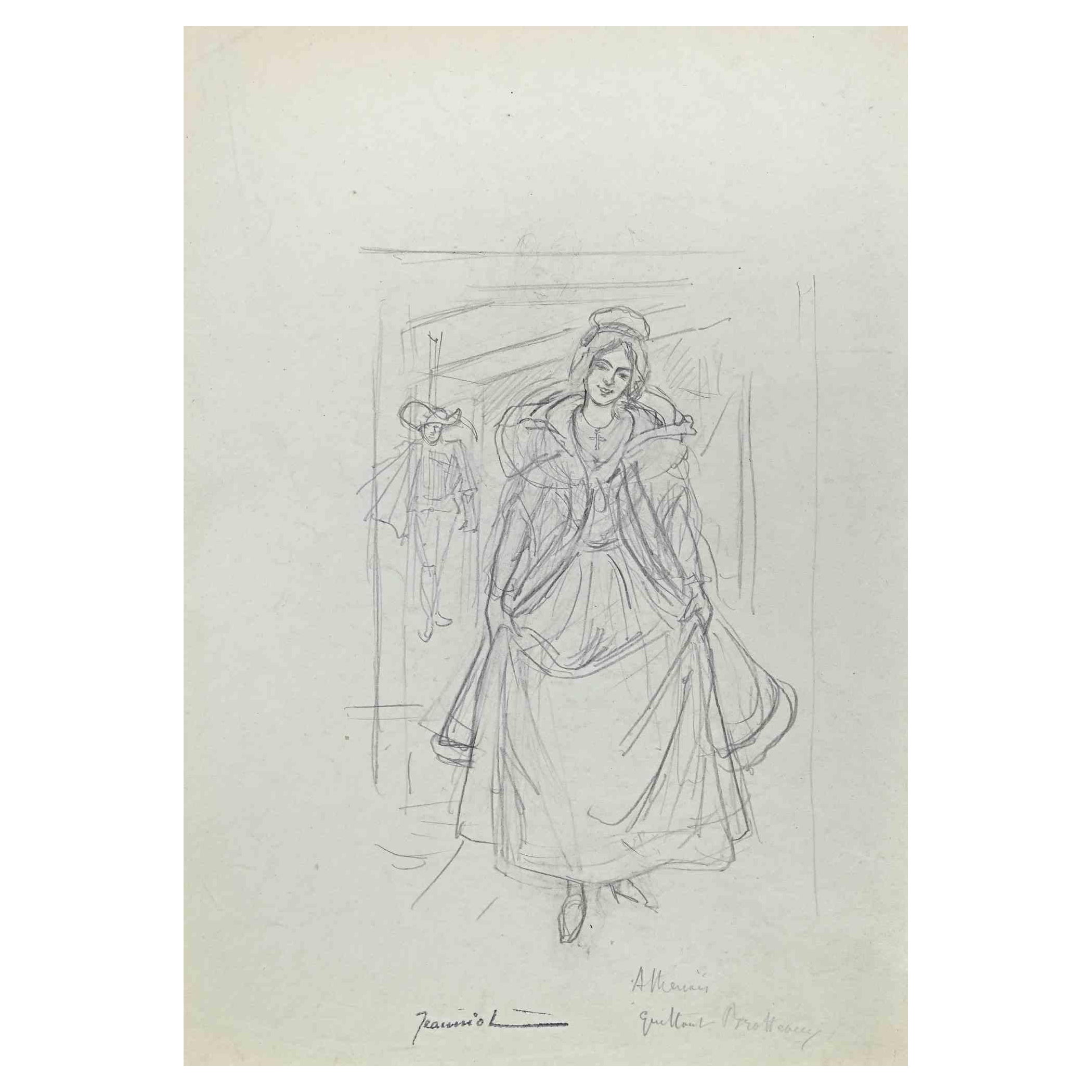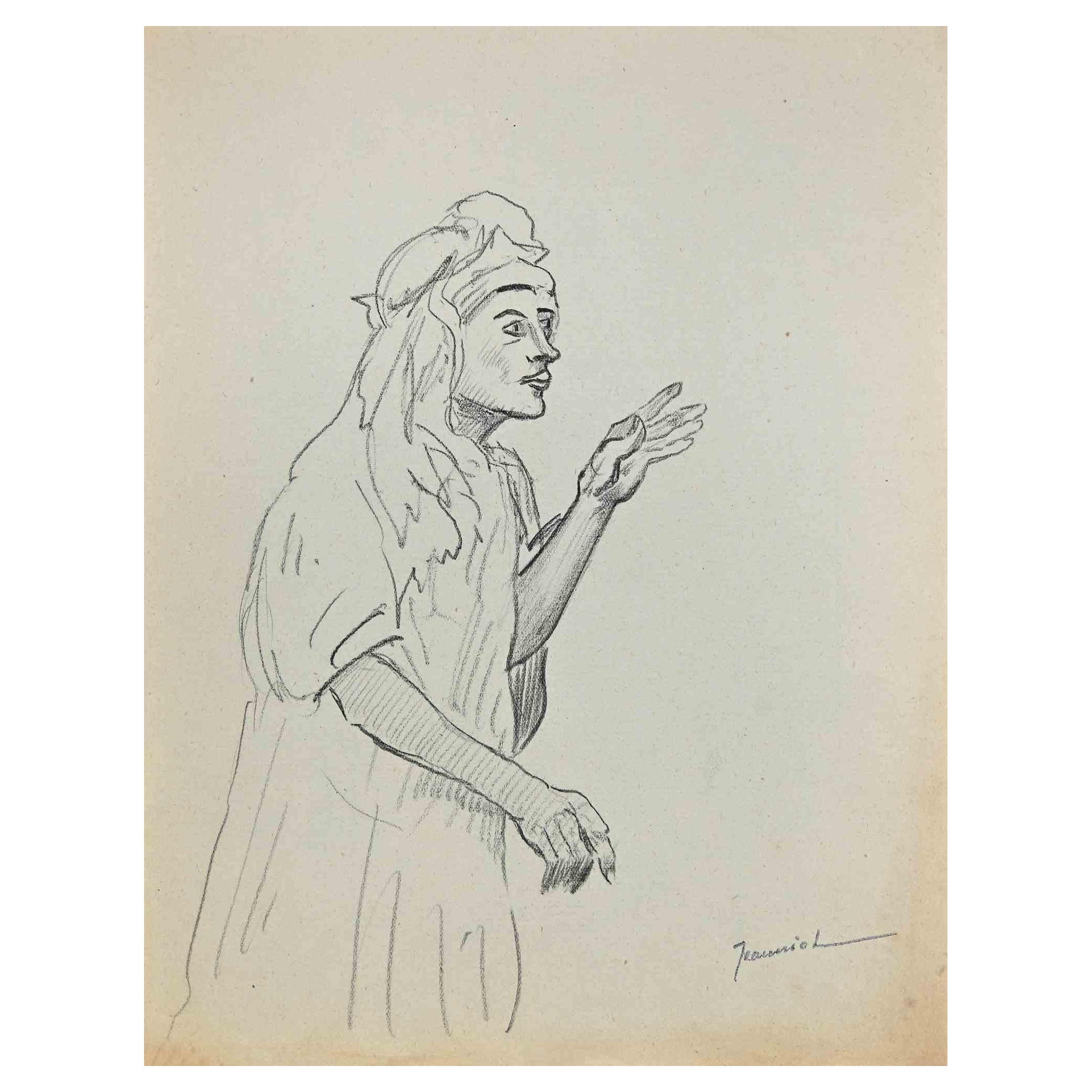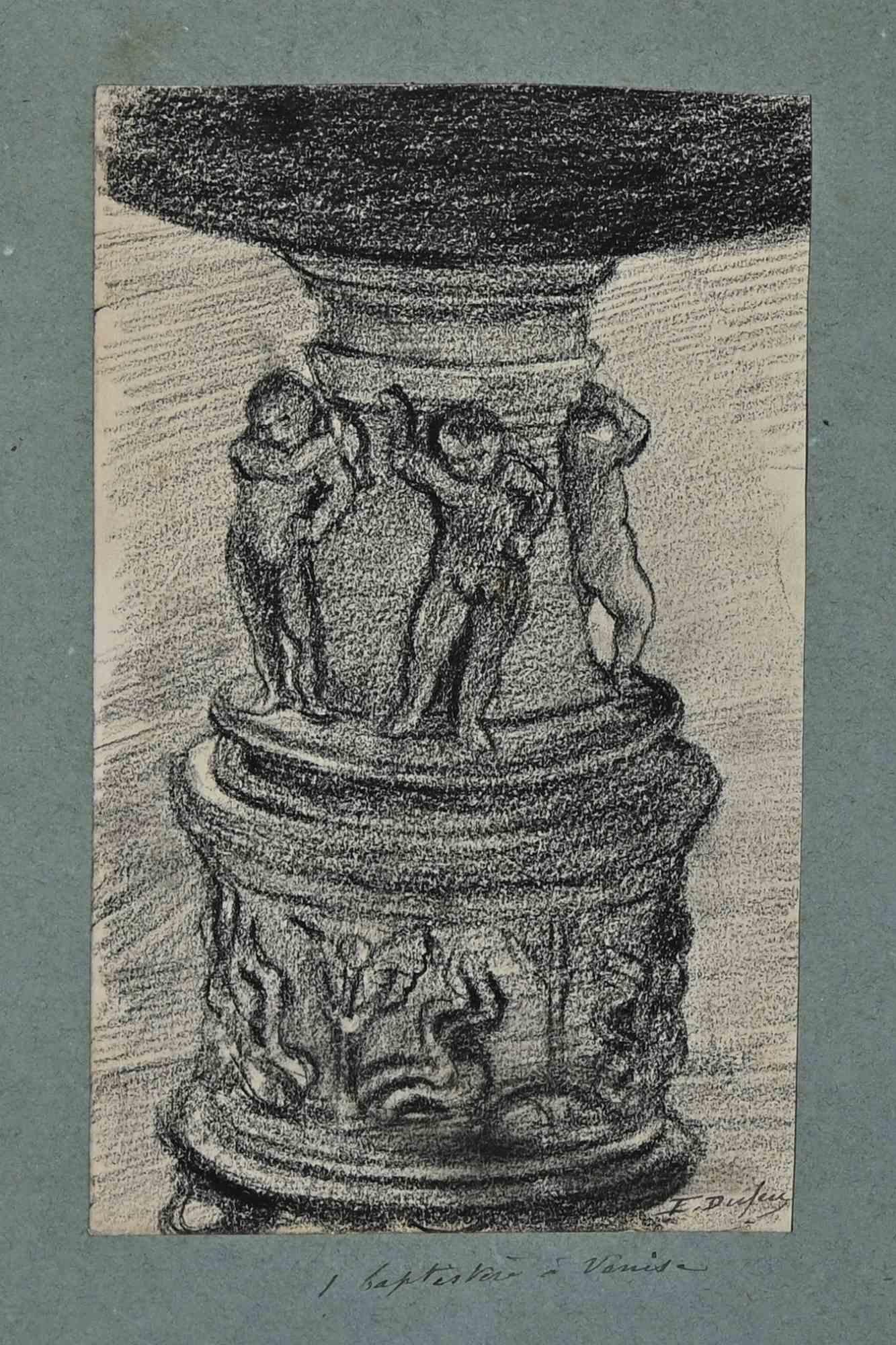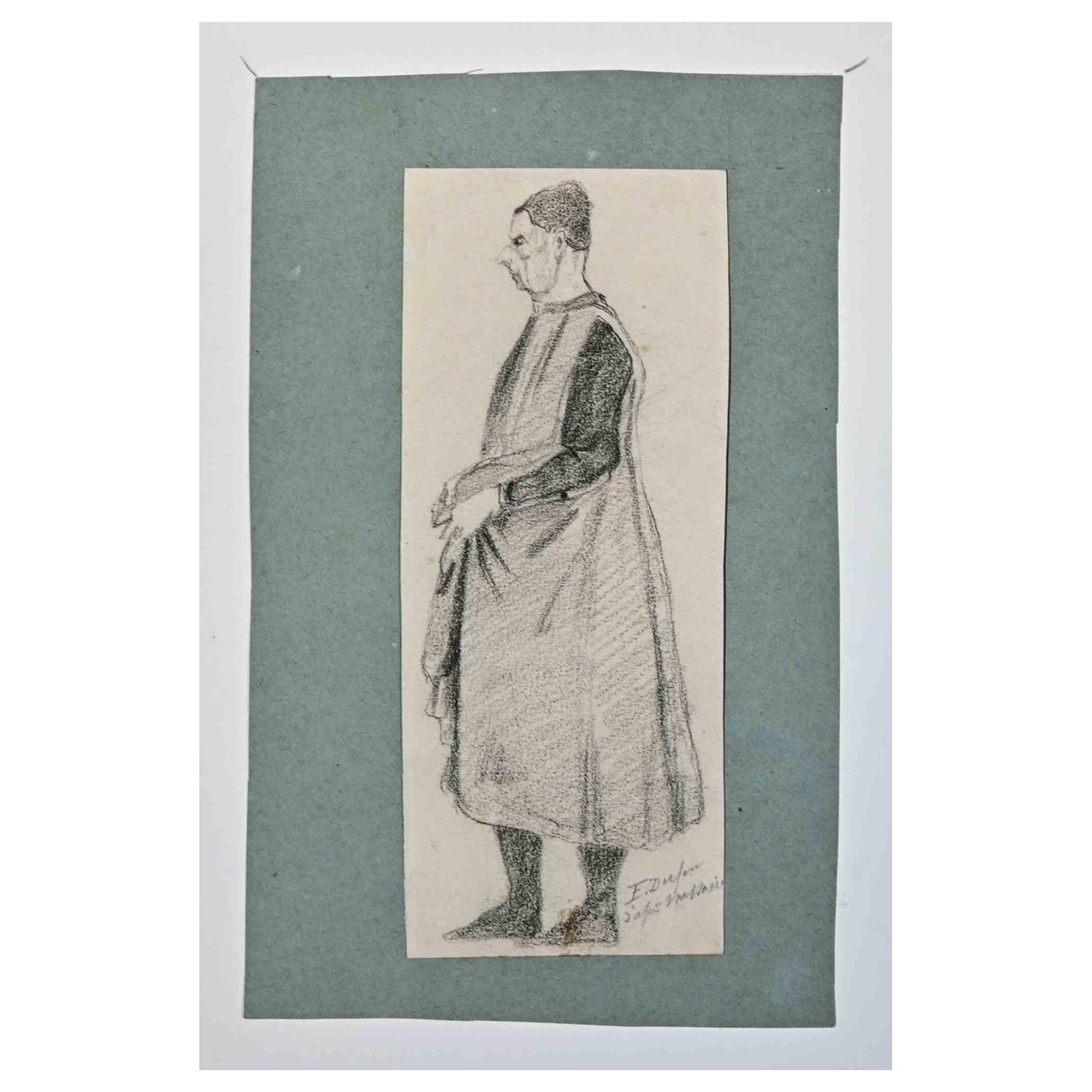Items Similar to Woman Figure - Pencil on Paper - 1853
Want more images or videos?
Request additional images or videos from the seller
1 of 2
Edmound De BeaumontWoman Figure - Pencil on Paper - 18531853
1853
About the Item
"Woman Figure" 1853's is a drawing on paper, signed and dated by Edmond De Beaumont, on the back of the drawing.
In excellent conditions: as good as new.
Sheet dimension: 15.8 x 12.3 cm.
This is an original drawing representing a model and showing a very rapid line and a synthetic touch with all the dignity of an autonomous artwork.
- Creator:
- Creation Year:1853
- Dimensions:Height: 6.23 in (15.8 cm)Width: 4.85 in (12.3 cm)Depth: 0.04 in (1 mm)
- Medium:
- Movement & Style:
- Period:
- Framing:Framing Options Available
- Condition:Insurance may be requested by customers as additional service, contact us for more information.
- Gallery Location:Roma, IT
- Reference Number:
About the Seller
4.9
Platinum Seller
These expertly vetted sellers are 1stDibs' most experienced sellers and are rated highest by our customers.
1stDibs seller since 2017
6,682 sales on 1stDibs
Typical response time: 2 hours
- ShippingRetrieving quote...Ships From: Principauté de Monaco, Monaco
- Return PolicyA return for this item may be initiated within 14 days of delivery.
More From This SellerView All
- Elegant Lady - Original Drawing By Pierre Georges Jeanniot - 1890sBy Pierre Georges JeanniotLocated in Roma, ITElegant Lady is an original Drawing on paper realized by painter Pierre Georges Jeanniot (1848-1934) in the 1890s. Drawing in Pencil. Hand-signed on the lower. Good conditions. P...Category
1890s Modern Portrait Drawings and Watercolors
MaterialsPencil
- The Sorcerer - Original Drawing By Pierre Georges Jeanniot - 1890sBy Pierre Georges JeanniotLocated in Roma, ITThe Sorcerer is an original Drawing on paper realized by painter Pierre Georges Jeanniot (1848-1934) in the 1890s. Drawing in Pencil. Hand-signed on the lower. Good conditions. P...Category
1890s Modern Portrait Drawings and Watercolors
MaterialsPencil
- The Vase - Drawing in Pencil By Edouard Dufeu - 1890sLocated in Roma, ITThe Vase is an original charcoal drawing on paper realized by Edouard Dufeu in the mid-20th century. Hand-signed on the lower. Included a white Passepartout: 37 x30 cm Good condit...Category
1890s Modern Figurative Drawings and Watercolors
MaterialsPencil
- Men of Church - Drawing in Pencil By Edouard Dufeu - 1886Located in Roma, ITMen of Church is an original drawing in pencil on paper realized by Edouard Dufeu in 1886. Hand-signed on the lower. Dated. Included a white Passeparto...Category
1880s Modern Figurative Drawings and Watercolors
MaterialsPencil
- Bishop - Drawing in Pencil By Edouard Dufeu - 1880sLocated in Roma, ITBishop is an original drawing in pencil on paper realized by Edouard Dufeu in the 1880s. Hand-signed on the lower. Included a white Passepartout: 37 x...Category
1880s Modern Figurative Drawings and Watercolors
MaterialsPencil
- Carriage - Original Drawing by Alexandre Bida - Mid 19th CenturyLocated in Roma, ITCarriage is an Original Pencil Drawing realized by Alexandre Bida (1823-1895). Good conditions. No signature. F. Alexandre Bida (1813–1895) was a Fre...Category
Mid-19th Century Modern Figurative Drawings and Watercolors
MaterialsPencil
You May Also Like
- French Modern Drawing by Jean Hélion - Veil HommeBy Jean HélionLocated in Paris, IDFVeil Homme 1947 drawing 26,9 x 21 cm Registered on the catalogue raisonné with inventory number : N°0252 cat. B sold without frame about Jean Hélion (April 21, 1904 – October 27, 19...Category
1960s Modern Figurative Drawings and Watercolors
MaterialsPencil, Paper
- Boston Abstract Expressionist Hyman Bloom Original Pencil Drawing Martin SumersBy Hyman BloomLocated in Surfside, FLThis is a unique artwork. This is an original Hyman Bloom drawing of fellow artist and his very good friend Martin Sumers.I believe this was drawn at the “variations of a theme” at Sumers gallery in NYC. The last two photos show a poster and a card from their shows. it is not included in this listing, it is just for provenance. Provenance: Acquired from the Sumers estate collection. Hyman Bloom (March 29, 1913 – August 26, 2009) was a Latvian-born American painter. His work was influenced by his Jewish heritage and Eastern religions as well as by artists including Altdorfer, Grünewald, Caravaggio, Rembrandt, Blake, Bresdin, James Ensor and Chaim Soutine. He first came to prominence when his work was included in the 1942 Museum of Modern Art exhibition "Americans 1942 -- 18 Artists from 9 States". MoMA purchased 2 paintings from the exhibition and Time magazine singled him out as a "striking discovery" in their exhibition review. His work was selected for both the 1948 and 1950 Venice Biennale exhibitions and his 1954 retrospective traveled from Boston's Institute of Contemporary Art to the Albright Gallery and the de Young Museum before closing out at The Whitney Museum of American Art in 1955. In a 1954 interview with Yale art professor Bernard Chaet, Willem de Kooning indicated that he and Jackson Pollock both considered Bloom to be “America’s first abstract expressionist”, a label that Bloom would disavow. Starting in the mid 1950s his work began to shift more towards works on paper and he exclusively focused on drawing throughout the 1960s, returning to painting in 1971. He continued both drawing and painting until his death in 2009 at the age of 9 Hyman Bloom (né Melamed) was born into an orthodox Jewish family in the tiny Jewish village of Brunavišķi in what is now Latvia, then part of the Russian Empire At a young age Bloom planned to become a rabbi, but his family could not find a suitable teacher. In the eighth grade he received a scholarship to a program for gifted high school students at the Museum of Fine Arts. He attended the Boston High School of Commerce, which was near the museum. He also took art classes at the West End Community Center, a settlement house. The classes were taught by Harold Zimmerman, a student at the School of the Museum of Fine Arts, who also taught the young Jack Levine at another settlement house in Roxbury. When Bloom was fifteen, he and Levine began studying with a well-known Harvard art professor, Denman Ross, who rented a studio for the purpose and paid the boys a weekly stipend to enable them to continue their studies rather than take jobs to support their families. He took Bloom and Levine on a field trip to the Museum of Modern Art in New York, where Bloom was impressed by the work of Rouault and Soutine and began experimenting with their expressive painting styles. In the 1930s Bloom worked sporadically for the Public Works of Art Project and the Federal Art Project (WPA), He shared a studio in the South End with Levine and another artist, Betty Chase. It was during this period that he developed a lifelong interest in Eastern philosophy and music, and in Theosophy. He first received national attention in 1942 when thirteen of his paintings were included in the Museum of Modern Art (MoMA) exhibition Americans 1942: 18 Artists from 9 States, curated by Dorothy Miller. MoMA purchased two of his paintings from that exhibition, and he was featured in Time magazine. The titles of his paintings in the exhibition reflect some of his recurring themes. Two were titled The Synagogue, another, Jew with the Torah; Bloom was actually criticized by one reviewer for including "stereotypical" Jewish images. He also had two paintings titled The Christmas Tree, and another titled The Chandelier, both subjects he returned to repeatedly. Another, Skeleton (c. 1936), was followed by a series of cadaver paintings in the forties, and The Fish (c. 1936) was one of many paintings and drawings of fish he created over the course of his career. Bloom was associated at first with the growing Abstract Expressionist movement. Willem de Kooning and Jackson Pollock, who first saw Bloom's work at the MoMA exhibition, considered Bloom "the first Abstract Expressionist artist in America." In 1950 he was chosen, along with the likes of de Kooning, Pollock, and Arshile Gorky, to represent the United States at the Venice Biennale. That same year Elaine de Kooning wrote about Bloom in ARTnews, noting that in paintings such as The Harpies, his work approached total abstraction: "the whole impact is carried in the boiling action of the pigment". In 1951 Thomas B. Hess reproduced Bloom's Archaeological Treasure in his first book, Abstract Painting: Background and American Phase, along with works by Picasso, Pollock, and others. Both de Kooning and Hess remarked on Bloom's expressive paint handling, a key characteristic of Abstract Expressionist painting. As abstract expressionism dominated the American art world, Bloom became disenchanted with it, calling it "emotional catharsis, with no intellectual basis." In addition, instead of moving to New York to pursue his career, he opted to stay in Boston. As a result he fell out of favor with critics and never achieved the kind of fame that Pollock and others did. He disliked self-promotion and never placed much value on critical acclaim. Many of Bloom's paintings feature rabbis, usually holding the Torah. According to Bloom, his intentions were more artistic than religious. He began questioning his Jewish faith early in life, and painted rabbis, he claimed, because that was what he knew. Over the course of his career he produced dozens of paintings of rabbis...Category
20th Century Modern Figurative Drawings and Watercolors
MaterialsPaper, Pencil
- DiversBy Jay Alan BabcockLocated in Saint Louis, MOJay Alan Babcock is a St. Louis-based graphic designer and painter. His work exhibits his interest in the visual language of Americana, including old ...Category
2010s American Modern Portrait Drawings and Watercolors
MaterialsCarbon Pencil
- Swim TeamBy Jay Alan BabcockLocated in Saint Louis, MOJay Alan Babcock is a St. Louis-based graphic designer and painter. His work exhibits his interest in the visual language of Americana, including old ...Category
2010s American Modern Portrait Drawings and Watercolors
MaterialsCarbon Pencil
- "March Avery in Beret, " Milton Avery, American Modernism, Portrait of ArtistBy Milton AveryLocated in New York, NYMilton Clark Avery (1885 - 1965) March Avery in a Beret, 1951 Black crayon and graphite on cream wove paper 11 x 8 3/8 inches Signed and dated lower left; ...Category
1950s American Modern Portrait Drawings and Watercolors
MaterialsPaper, Crayon, Pencil, Graphite
- Surprised Woman with Cactus 1920s Female IllustratorBy Susan FlintLocated in Miami, FLThe postman's delivery of a limp cactus creates a big emotional response the female recipient. Most likely an interior illustration for a newsstand magazine. Signed lower right Sus...Category
1930s American Modern Figurative Drawings and Watercolors
MaterialsPaper, Graphite




